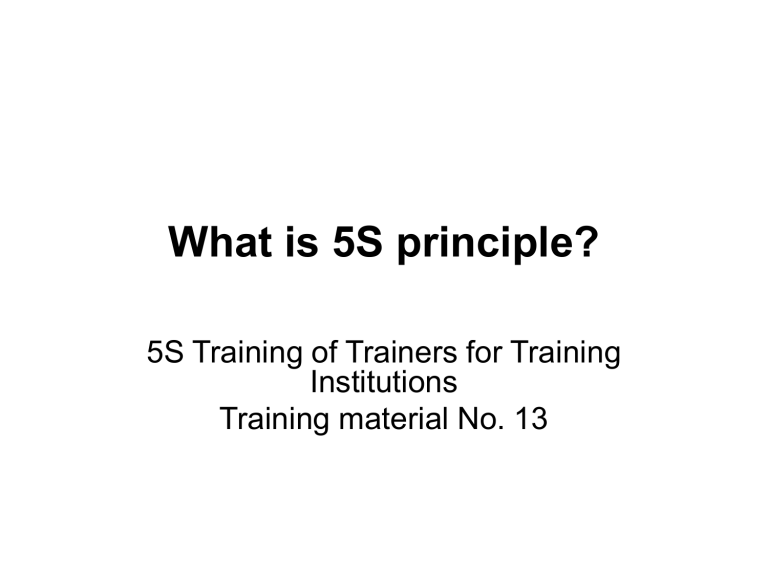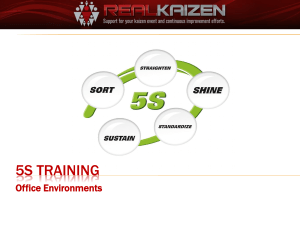
What is 5S principle? 5S Training of Trainers for Training Institutions Training material No. 13 Aren’t you frustrated in your workplace? Oh, this position makes me tired ! Where is that document ? I cannot find it ! Oh time is not enough to complete this work! I cannot remember what/how to next… Why I am making mistakes again and again Why we cannot communicate properly? Are you positive thinker or negative thinker? 3 Thinking negatively in inside box and give-up? 4 Work together and do something with big positive attitude? 5 Even you are positive thinker, you still need something to make your ideas realistic You need tools ! 6 There are useful tools 5S approaches 7 What is 5S ? • 5S is a philosophy and a way of organizing and managing the workspace and work flow with the intent to improve efficiency by eliminating waste, improving flow and reducing process unreasonableness. It is for improvement of working environment 8 What is 5S ? • 5S activities are to create good working environment through reduction of “Muri”, “Mura”, and “Muda” • It help to have a basis of strong management of workplace • What is “Muri”, “Mura”, and “Muda”? – Muri : overburden, unreasonableness or absurdity – Mura : unevenness or inconsistency, primarily with physical matter and the human spiritual condition – Muda : activity which is wasteful or doesn’t add value Source: http://blog.5stoday.com/category/muri-mura-muda/ 5S in Japanese/English/Swahili 5S is literally five abbreviations of Japanese terms with 5 initials of S. Japanese English Ki-Swahili S-1 Seiri Sort Sasambua S-2 Seiton Set Seti S-3 Seiso Shine Safisha S-4 Seiketsu Standardize Sanifisha S-5 Sitsuke Sustain Shikilia 10 Background on 5S activities • The word “5S(five S)” was generalized in 1980’s in manufacturing sector in Japan, as Toyota Production System (TPS) became famous in the sector and “5S activities” were set as one of the bases of TPS • Service industry started to used “5S” in 1990’s Background: - National Demonstration Project • NDP was designed to test TQM approach for health care quality and safety improvement • NDP was conducted in US (1989-1990) and Japan (2000-2004) • Many private hospitals in Asia, Europe, and US are practicing KAIZEN-TQM approaches for health care quality, hospitals management and safety improvement 12 What 5S can do? 13 Team work improvement through everyone’s participation 14 Identify Abnormalities 15 Identify wastes and reduce the wastes 16 The 7 wastes Overproduction Over processing Rework Transportation Inventory Waiting Motion Mr. Taiichi Ohno, Former President of Toyota Motors 17 Improve productivities 18 Improve safety 19 If no 5S activities…. Hesitate what to do Remember what / how to do Looking for necessary items Making mistake Details of 5S approach 21 5S: Sort-Set-Shine-Standardize-Sustain S1: Sort S5: Sustain S4: Standardize S2: Set S3: Shine 22 S1: Sort • Focuses on eliminating unnecessary items from the workplace • Categorize equipment, furniture, tool in your working place into the following 3 categories 1. 2. 3. • Necessary Unnecessary May not necessary This step will also help with the “just in case” attitude S1: Sort S5: Sustain S4: Standardize S2: Set S3: Shine 23 Back to main S1: Sorting activities Equipment, material, tools files, furniture etc. can be categorized based on the frequency of use! Equipment, materials tools etc. in your work place May need it Items only used occasionally are in this category Not need it Need it Items not used in current work process are in this category Items often use are in this category Examples of “Sorting” • Place “Red tag” for categorization of items to identify unnecessary items • Move unnecessary items( broken tools, obsolete jigs and fixtures, scrap and excess raw material etc.) to central stored area • Free up valuable floor space (Space utilization) • Finding abnormality of equipment and tools (Out of order, missing parts etc.) 25 26 S2: Set • “Set” is based on finding efficient and effective storage of necessary items • Apply “Can see, Can take out, and Can return” philosophy • This will save time and energy to look for something S1: Sort S5: Sustain S4: Standardize S2:Set S3: Shine 27 Back to main S2: Setting activities Think not only “beatification. Need to consider workflow and arrange items • Needed items • Items often use (with current work process) Have consensus among co-workers on where and how to organize necessary items Use 5S tools for proper Organization of items such as • Labeling • Color coding • Numbering • Zoning etc. Arrange them properly based on “Can see, Can take-out, Can return” Philosophy Example of “Setting” activities • Labeling , numbering, zoning for clear identification of storage areas to keep necessary items • Set necessary items matching with workflow to minimize unnecessary movement and transportation time 29 BASELINE ADMINISTRATION PHOTOGRAPHS AUGUST 2008 Before 5S PROCESS MID. YEAR SEPTEMBER 2008 After 5S 30 S3: Shine • Cleaning up one’s workplace daily so that there is no dust on floors, machines or equipment. • It will create ownership and build pride in the workers S1: Sort S5: S2: Sustain Set S4: Standardize S3: Shine 31 Back to main S3: Shining activities • Clean floor, windows and walls. • Clean and Maintain office automation machines, medical equipment and tools, office furniture • Develop and follow regular cleaning and Maintenance schedule Example of “Shining” activities • Daily sweeping and mopping of floor, bathroom, corridor etc. • Regular cleaning and maintenance of equipment and tools • Periodical check for changes in equipment and the service area such as: leaks, vibration, misalignment, breakage etc. • IPC activities such as hand hygiene, waste segregation are also part of shine 33 34 S4: Standardize • Maintain an environment where S1 to S3 are implemented in the same manner throughout the organization • Give opportunities to employees to take active part in the development of these standards. S1: Sort S5: S2: Sustain Set S4: S3: Standardize Shine 35 Back to main S4: Standardizing activities S1 S2 S3 Develop mechanism to standardize S1-S3 implementation for continuation Standardization will leads equalization of activities = “Production leveling and smoothing” Standardization is useful for; • Easy implementation of S1 to S3 activities • Equalization process output • Everyone’s participation Example of “Standardize” activities • Work instructions, Standard Operating Procedures (SOPs) • Checklist development and regular usage for SOPs • Mechanism and format development for ordering supplies, reporting etc • Color coding for waste segregation • Standardized common symbols 37 38 S5 : Sustain • Maintain S1-S4 through discipline, commitment and empowerment • It focuses on defining a new mindset and a standard in workplace S1: Sort S5: S2: Set Sustain S4: S3: Standardize Shine 39 Back to main S5: Sustainability activities People get bored if no changes. Need to develop a mechanism to make staff exited and motivated Further Improvement Prevent fallback Improvement Measure improvement with proper periodical monitoring Example of “Sustain” activities • Regular progress reporting • Refresher training • Periodical evaluation of 5S activities with proper advices for continuation and further improvements • Appreciation, recognition and awarding on good 5S activities • Reminder using 5S corner, new letters, good practice sheet etc. 41 42 5S Conceptual Framework SORT SUSTAIN STANDARDIZE SET SHINE 43 5S is becoming popular for seven solid reasons 1. Visible results enhance the generation of more and new ideas 2. The workplace gets cleaned up and better organized 3. Hospital and office operations become easier and safer 4. Results are visible to everyone - insiders and outsiders 5. People are naturally disciplined 6. People take pride in their clean and organized workplace 7. As a result the company’s good image generates more better 44 5S-KAIZEN-TQM Phases Preparatory phase 3 month •Situation analysis •Training of managers Introductory Phase 6 month •Training of staff •Sorting •Setting •Shining Implementation phase 2 years •Standardizing •Sustaining •Expansion areas to practice 5S activities Maintenance phase On going • Continue 5S cycle 45 Target of 5S Targets of Five-S include: Zero changeovers leading to product/ service diversification Zero defects leading to higher quality Zero waste leading to lower cost Zero delays leading to on time delivery Zero injuries promoting safety Zero breakdowns bringing better maintenance 46 Remember (1/2) • 5S implementation can improve both working environment and the service content. – Benefits on WEI will be better realized as you go along the training. • Go systematically to implement S1-S5: – Sort necessary & unnecessary items; – Arrange items according to work flow; – Make workplace and tools shining (daily cleaning); – Standardize “sort-set-shine” process; and – Workers acquire positive attitude to sustain & improve quality of health services. 47 Remember (2/2) • Effectiveness of 5S in improving health care services content: – Complement to patient safety efforts, e.g., • Minimizes chances of providing wrong medicine, and treating wrong patients through proper sorting (files, records) and appropriate labeling (medicines, op-sites), as well as, use of checklist to avoid leaving items (such as gauze and scissors) by use of safe surgery checklist. – Contribute to better continuum of care, e.g., • Use of patient discharge checklists ensure correct linkages to needed services. 48 Example of 5S activities Before 5S (2009) After 5S (2010) Disorganized items in the store. Took long time to searching items needed Use labeling and organize items lead to minimize time for searching items, easy to control stocks 49 Example of 5S activities Before 5S Disorganized cabinet in a ward at Usangi DH After 5S 50 Using color coding for Visual control of ampules in a ward at MNH Green means “enough stock” Yellow means giving warning on Red means giving warning on “stock is getting less” “close to stock out and refill ” Wrap-up • Positive attitude is very important for implementation of 5S activities • It is not “Cleaning Campaign” • 5S activities are to create good working environment through reduction of “Muri”(overburden), “Mura”(unevenness), and “Muda”(waste) • 5S can identify and reduce “abnormalities” and “waste”, improve “team work”, “cleanness”, “safety” and “productivity” • It is a basis of organization management Thank you for listening !
